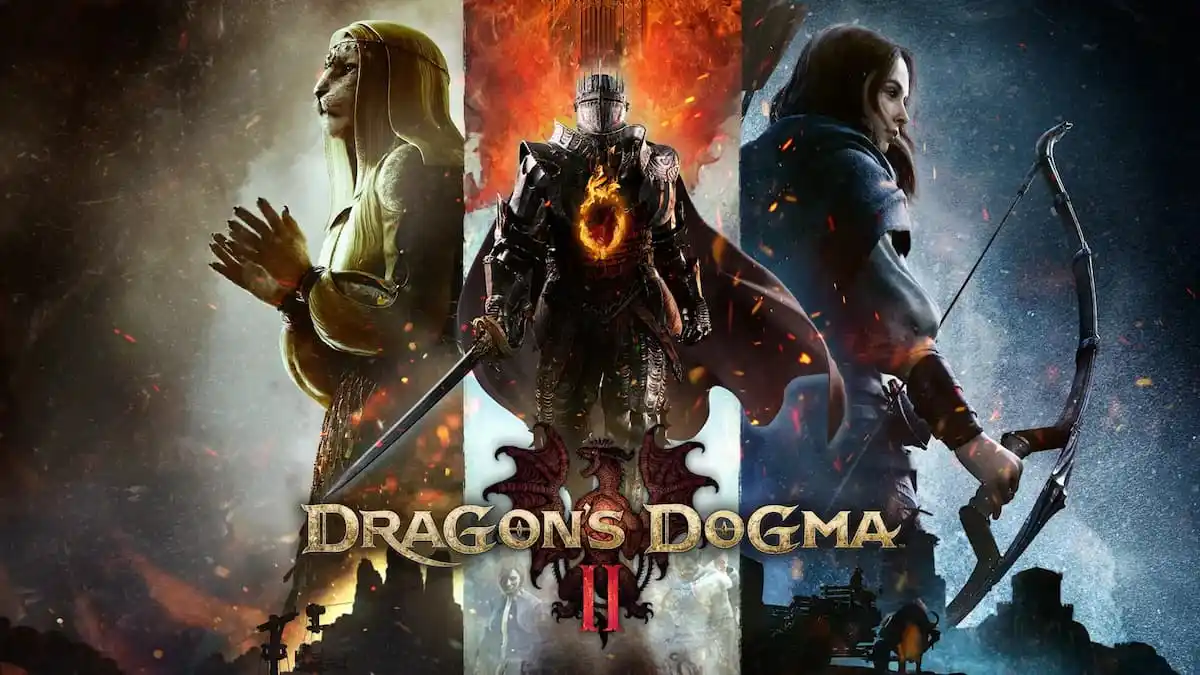Tomas Sala’s debut game The Falconeer, released on the 10th of November 2020 as a launch title for the Xbox Series X/S. A gorgeous aerial combat game where you pilot a giant falcon around the mysterious world of the Ursee; fighting enemies, delivering mail and slowly discovering a beautiful ocean covered landscape.
Bulwark: Falconeer Chronicles is the second outing from Sala and a deeper exploration into the world and politics of the Ursee. In this new title we’ve pivoted away from the aerial combat of the first game to a city builder-like. I say like, because this doesn’t feel like any city builder I’ve ever played. Yes you build settlements and outposts; yes you gather resources to upgrade these settlements and of course, you have to defend them from harm. Unlike other city builders, however, this all takes place in a world fully covered by water. Instead of sending out various denizens of your outpost to search for resources you fly your Surveyor across the vast ocean, setting up harbours and trade routes, picking up refugees and making alliances with other factions.
A Resource Management Maze
The world of the Ursee is vast and beautiful, with pockets of resources, refugees and survivors of the War of the Tree. In the 1st campaign mission, that also serves as a tutorial, you’re gradually introduced to the city building aspect of the game and the four factions (Freehouses, Mancers, Imperium and Bannerless). Starting with a Freehouse outpost, you need to find access to Wood, Stone and Iron to expand and upgrade your settlements. This is where the unique mechanics first start to show. Resources are moved around your city using pathways connected by towers and the number of each resource being generated indicates how many pathways it can travel before being ‘depleted’.
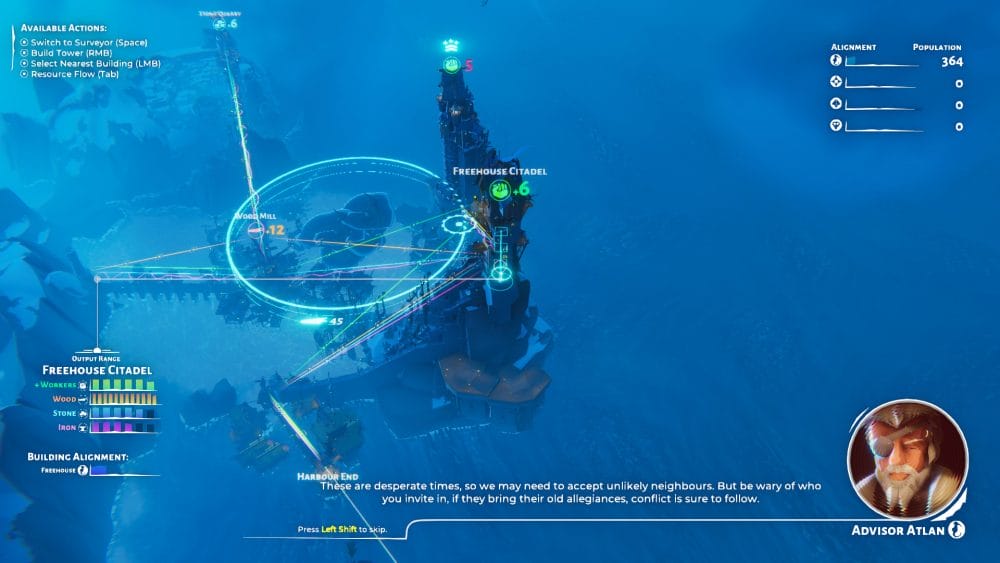
You can toggle the resource flow view to check how far each resource is travelling and use this to optimise your building plans and pathing. I’m not ashamed to say that I didn’t figure out this mechanic immediately and had some pretty nonoptimal setups at first! Luckily you can demolish anything previously built with no cost of resources – as Tomas himself says upon start up, you can’t make mistakes just explore for yourself – and rearrange things to better suit your needs. You can also increase the amount of resources beings generated by building up foundations around your main buildings. In real time as you build outwards (and more visually interesting, upwards) your settlers will build houses and storage structures representing the unique resource around them. It makes for a visual treat, seeing your colony grow and evolve in response to your actions and their own needs.

Into the Blue
Once you have set up your small home citadel using nearby resources, you’ll need to venture out into the vast ocean to find more upgrade materials; recruit people to your forces, and forge alliances to progress. This adds the second unique mechanic into the game. Trade routes. Obviously these aren’t unique in themselves, but Bulwark handles them with a dichotomy of simplicity and complexity that I found thoroughly enjoyable. You build trade routes between resources or other settlements using harbours and to each you assign up to 3 captains to sail that route – sounds simple enough, but choose your captains wisely! Captains are limited towards the start of the game (although more turn up later) and they will only carry certain cargo. Optimising which captain should run each route was like a mini puzzle within the wider jigsaw of settlement building. They are also aligned with a specific faction, meaning they may stop working with you if tensions between yourself and that faction spill over into conflict! The more you play the more types of trade routes you uncover, some are long and treacherous requiring you to assign war boats to protect your resources; others are between conflicting factions that certain captains won’t sail. It’s such an engaging mechanic, and I frequently studied my soul tree to see if I could better arrange my captains to get more resources flowing!
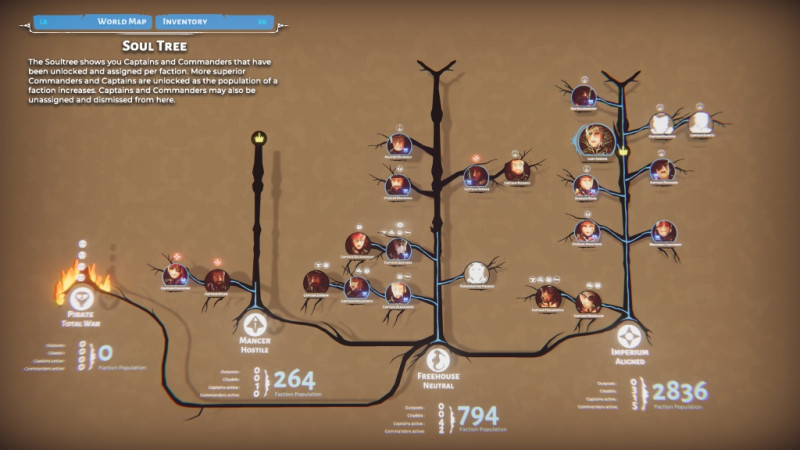
Speaking of the Soul Tree – this is where you can see all of your factional connections. You’ll see your captains and commanders, what faction they hail from and your population of each. During my first playthrough of Chapter One I hit a milestone with the Mancers and started receiving many more advanced people aligned with them. I also, may have, declared war on the Bannerless and quickly had to patch up relations so as to not lose some of my best seafarers!
Next to the Soul Tree, you’ll find your Map and Inventory. I found the Map the best way to navigate around the Ursee as you can point your surveyor where you would like to go and upon closing, it will follow that trajectory, but you can also move it on the overworld by clicking in a certain direction. Your inventory shows what buildings your surveyor currently holds, from settlements to lighthouse to resource extractors. You find these building by exploring, so don’t be tempted to just sit in one spot!
Surveying the Sea
As mentioned above, outside of your settlements the main gameplay loop is exploring the Ursee with your Surveyor. The Surveyor looks something akin to a blimp, and it serves many purposes. Moving it around the map finds new captains, new commanders, buildings and anomalies (which in turn allow new things to be found). It is also your main line in defence for your colonies and trade routes. When you install a commander at tower (or enter into a alliance with another colony) you may get upgrades to your fleet – adding a host of mini blimps, falconeers and even small dragons flying alongside you into battle with those unlucky enough to target your ships.
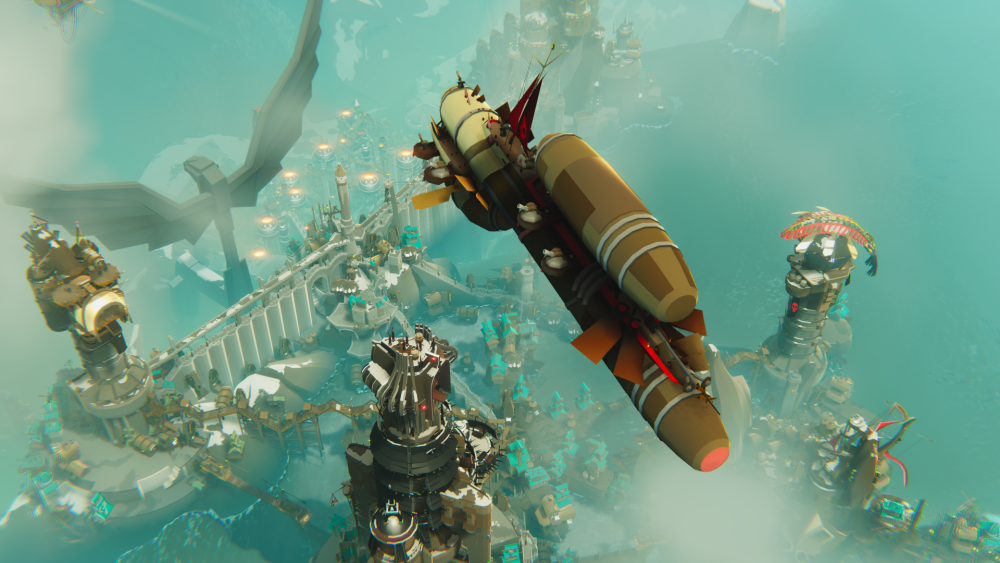
You transfer from building mode to your Surveyor with one button, and back again with the same. The control scheme in general is incredibly simple with very few buttons to get used to. I played using MKB for the first few hours, but afterwards switched to controller in order to check out the difference. MKB took a small amount of time to get used to due to the unique controls but was fine once I got the hang of it, but the controller set up was such a streamlined experience I would fully recommend starting and playing with that. The amount of functionality coded into basically only 3 buttons was marvellous, simply stellar design in action.Â
Overall
You don’t really finish Bulwark – not just because of it’s fantastic free build mode, but in my ~20 hours with it I feel like I got a good grasp of it’s intricacies and the world of the Ursee. The tutorial is brief and allows you to get stuck in almost immediately – which can lead to some confusion about certain mechanics, but given there’s no real fail state you can have fun exploring, building and figuring everything out at your own pace. Sometimes this can lead to a lull in discoveries or progression that some people might find a little bit frustrating, but exploring more almost always yields new things to find.
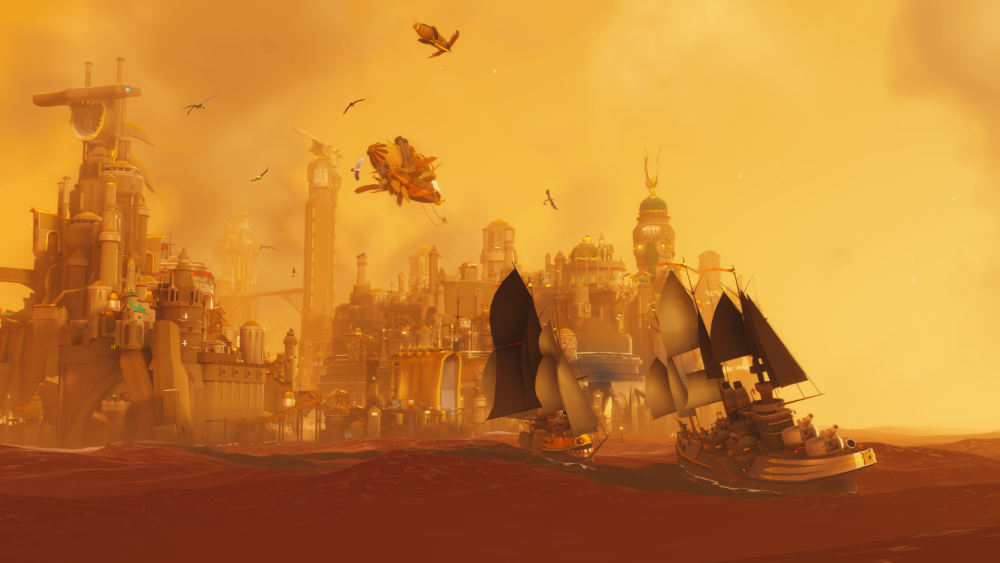
The world itself is beautiful, with an almost impressionist painting quality – all brush strokes and washes of colour. The factions are fleshed out and interesting, really drawing you into the background and lore of this world. There’s also some great voice work from the various people you interact with as you progress each faction’s alliances or choose to fire up post war tensions even more. It also has a host of Twitch integration features – that I, myself didn’t use as a non streamer, but look like a fun way to give your chat agency over alliances/feuds or more likely just throw your entire world into chaos!
All in all, Bulwark: Falconeer Chronicles is a game absolutely like no other and whether you enjoy city builders, resource management games or unique independent experiences it is one I would not hesitate to recommend.

Bulwark: Falconeer Chronicles was reviewed on PC – thank you to Wired Productions for the code. It is available on March 26th for PS4/PS5, Xbox One, Xbox Series X/S and Linux.



